Inventory and Distribution of Rock Glaciers in Northeastern Yakutia
Abstract
1. Introduction
2. Materials and Methods
2.1. Research Area
2.2. Research Methods
3. Results
3.1. Distribution of Rock Glaciers on Mountain Ranges
3.1.1. Suntar-Khayata Range
3.1.2. Chersky Range
3.1.3. Momsky Range
3.1.4. Verkhoyansky Range
3.2. Field Observations
3.2.1. Morphology of Rock Glaciers of the Burgali River Basin
3.2.2. Morphology of Rock Glaciers of the Kureter River Basin
4. Discussion
5. Conclusions
Funding
Conflicts of Interest
References
- Barsch, D. Rockglaciers: Indicators for the Present and Former Geoecology in High Mountain Environments; Springer Series in Physical Environment; Springer: Berlin, Germany, 1996. [Google Scholar]
- Colucci, R.R.; Boccali, C.; Žebre, M.; Guglielmin, M. Rock glaciers, protalus ramparts and pronival ramparts in the South-Eastern Alps. Geomorphology 2016, 269, 112–121. [Google Scholar] [CrossRef]
- Kellerer-Pirklbauer, A.; Rieckh, M. Monitoring nourishment processes in the rooting zone of an active rock glacier in an alpine environment. Z. Geomorphol. Suppl. 2016, 60, 99–121. [Google Scholar] [CrossRef]
- Uxa, T.; Mida, P. Rock glaciers in the Western and High Tatra Mountains, Western Carpathians. J. Maps 2017, 13, 844–857. [Google Scholar] [CrossRef]
- Fernandes, M.; Palma, P.; Lopes, L.; Ruiz-Fernández, J.; Pereira, P.; Oliva, M. Spatial distribution and morphometry of permafrost-related landforms in the Central Pyrenees and associated paleoclimatic implications. Quat. Int. 2018, 470, 96–108. [Google Scholar] [CrossRef]
- Rangecroft, S.; Harrison, S.; Anderson, K.; Magrath, J.; Castel, A.P.; Pacheco, P. A first rock glacier inventory for the Bolivian Andes. Permafr. Periglac. Process. 2014, 25, 333–343. [Google Scholar] [CrossRef]
- Azócar, G.F.; Brenning, A.; Bodin, X. Permafrost distribution modelling in the semi-arid Chilean Andes. Cryosphere 2017, 11, 877–890. [Google Scholar] [CrossRef]
- Esper Angillieri, M.Y. Permafrost distribution map of San Juan Dry Andes (Argentina) based on rock glacier sites. J. S. Am. Earth Sci. 2017, 73 (Suppl. C), 42–49. [Google Scholar] [CrossRef]
- Munroe, J.S. Distribution, evidence for internal ice, and possible hydrologic significance of rock glaciers in the Uinta Mountains, Utah, USA. Quat. Res. 2018, 90, 50–65. [Google Scholar] [CrossRef]
- Millar, C.; Westfall, R.D. Rock-glaciers and related periglacial landforms in the Sierra Nevada, CA, USA: Inventory, distribution and climatic relationships. Quat. Int. 2008, 188, 90–104. [Google Scholar] [CrossRef]
- Bolch, T.; Gorbunov, A.P. Characteristics and origin of rock glaciers in Northern Tien Shan (Kazakhstan/Kyrgyzstan). Permafr. Periglac. Process. 2014, 25, 320–332. [Google Scholar] [CrossRef]
- Jones, D.B.; Harrison, S.; Anderson, K.; Selley, H.L.; Wood, J.L.; Betts, R.A. The distribution and hydrological significance of rock glaciers in the Nepalese Himalaya. Glob. Planet. Chang. 2018, 160 (Suppl. C), 123–142. [Google Scholar] [CrossRef]
- Ran, Z.; Liu, G. Rock glaciers in Daxue Shan, south-eastern Tibetan Plateau: An inventory, their distribution, and their environmental controls. Cryosphere 2018, 12, 2327–2340. [Google Scholar] [CrossRef]
- Blöthe, J.H.; Rosenwinkel, S.; Höser, T.; Korup, O. Rock-glacier dams in High Asia. Earth Surf. Process. Landf. 2019, 44, 808–824. [Google Scholar] [CrossRef]
- Gorbunov, A.P.; Gorbunova, I.A. Geography of Rock Glaciers of the World; A Partnership of Scientific Editions KMK: Moscow, Russia, 2010. (In Russian) [Google Scholar]
- Gorbunov, A.P.; Gorbunova, I.A. Geography of Rock Glaciers and Their Analogues in Eurasia; Institute of Geography: Almaty, Kazakhstan, 2013. (In Russian) [Google Scholar]
- Sollid, J.L.; Etzelmuller, B. Soerbel, Rock Glaciers from Norway and Svalbard, Version 1; NSIDC—National Snow and Ice Data Center: Boulder, CO, USA, 1988. [Google Scholar] [CrossRef]
- Wahrhaftig, C.; Cox, A. Rock glaciers in the Alaska Range. Geol. Soc. Am. Bull. 1959, 70, 383–436. [Google Scholar] [CrossRef]
- Jones, D.B.; Harrison, S.; Anderson, K.; Betts, R.A. Mountain rock glaciers contain globally significant water stores. Sci. Rep. 2018, 8, 2834. [Google Scholar] [CrossRef] [PubMed]
- Jones, D.B.; Harrison, S.; Anderson, K.; Whalley, W.B. Rock glaciers and mountain hydrology: A review. Earth Sci. Rev. 2019, 193, 66–90. [Google Scholar] [CrossRef]
- Delaloye, R.; Barboux, C.; Bodin, X.; Brenning, A.; Hartl, L.; Hu, Y.; Ikeda, A.; Kaufmann, V.; Kellerer-Pirklbauer, A.; Lambiel, C.; et al. Rock glacier inventories and kinematics: A new IPA Action Group. In Proceedings of the 5th European Conference on Permafrost, Chamonix, France, 23 June–1 July 2018; Deline, P., Bodin, X., Ravenel, L., Eds.; Université Savoie Mont Blanc: Chamonix, France, 2018; pp. 392–393. [Google Scholar]
- Gorbunov, A.P. Rock glaciers of the Asian Russia. Earth’s Cryosphere 2006, 10, 22–28. (In Russian) [Google Scholar]
- Galanin, A.A. Rock glaciers of north-eastern Asia: Mapping and geographical analysis. Earth’s Cryosphere 2009, 13, 49–61. (In Russian) [Google Scholar]
- Galanin, A.A. Rock glaciers in the southern Chukchi Peninsula. Geomorfologiya 2017, 1, 66–79. (In Russian) [Google Scholar] [CrossRef][Green Version]
- Lytkin, V.M.; Galanin, A.A. Rock glaciers in the Suntar-Khayata Range. Lëd Sneg 2016, 56, 511–524. (In Russian) [Google Scholar] [CrossRef][Green Version]
- Ananicheva, M.D.; Kapystin, G.A.; Koreicha, M.M. Changing the glaciers in the Suntar-Khayata and Chersky mountains systems is assessed by Landsat imagery (2001 and 2003) and the USSR Glacier Inventory (published in 1970s). Data Glaciol. Stud. 2006, 101, 163–168. (In Russian) [Google Scholar]
- Grave, N.; Gavrilova, M.; Gravis, G.; Katasonov, E.; Klyukin, N.; Koreysha, G.; Kornilov, B.; Chistotinov, L. The Freezing of the Earth’s Surface and Glaciation on the Range Suntar-Khayata (Eastern Yakutia); Nauka: Moscow, Russia, 1964. (In Russian) [Google Scholar]
- Zhang, Y.; Wang, X.; Jiang, Z.; Wei, J.; Enomoto, H.; Ohata, T. Glacier Surface Mass Balance in the Suntar-Khayata Mountains, Northeastern Siberia. Water 2019, 11, 1949. [Google Scholar] [CrossRef]
- Zhang, Y.; Enomoto, H.; Ohata, T.; Kadota, T.; Shirakawa, T.; Tekeuchi, N. Surface Mass Balance on Glacier No. 31 in the Suntar–Khayata Range, Eastern Siberia, from 1951 to 2014. J. Mt. Sci. 2017, 14, 501–512. [Google Scholar] [CrossRef]
- Shirakawa, T.; Kadota, T.; Fedorov, A.; Konstantinov, P.; Suzuki, T.; Yabuki, H.; Nakazawa, F.; Tanaka, S.; Miyairi, M.; Fujisawa, Y.; et al. Meteorological and Glaciological Observations at Suntar-Khayata Glacier No. 31, East Siberia, from 2012–2014. Bull. Glaciol. Res. 2016, 34, 33–40. [Google Scholar] [CrossRef]
- Tanaka, S.; Takeuchi, N.; Miyairi, M.; Fujisawa, Y.; Kadota, T.; Shirakawa, T.; Kusaka, R.; Takahashi, S.; Enomoto, H.; Ohata, T.; et al. Snow Algal Communities on Glaciers in the Suntar-Khayata Mountain Range in Eastern Siberia, Russia. Polar Sci. 2016, 10, 227–238. [Google Scholar] [CrossRef]
- Takeuchi, N.; Fujisawa, Y.; Kadota, T.; Tanaka, S.; Miyairi, M.; Shirakawa, T.; Kusaka, R.; Fedorov, A.; Konstantinov, P.; Ohata, T. The Effect of Impurities on the Surface Melt of a Glacier in the Suntar-Khayata Mountain Range, Russian Siberia. Front. Earth Sci. 2015, 3, 82. [Google Scholar] [CrossRef]
- Takahashi, S.; Sugiura, K.; Kameda, T.; Enomoto, H.; Kononov, Y.; Ananicheva, M.; Kapustin, G. Response of Glaciers in the Suntar-Khayata Range, Eastern Siberia, to Climate Change. Ann. Glaciol. 2011, 52, 185–192. [Google Scholar] [CrossRef]
- Galanin, A.A.; Lytkin, V.M.; Fedorov, A.N.; Kadota, T. Recession of glaciers in the Suntar-Khayata Mountains and methodological consideration of its assessment. Ice Snow 2013, 4, 30–42. [Google Scholar] [CrossRef]
- Ananicheva, M.D.; Karpachevsky, A. Glaciers of the Orulgan Range: Assessment of the current state and possible development for the middle of the 21st century. Environ. Earth Sci. 2015, 74, 1985–1995. [Google Scholar] [CrossRef]
- Nekrasov, I.A.; Sheikman, V.S. USSR Glacier Inventory. V. 17. Is/7. Pt. 2,4. V. 17. Pt. 4.; Hydrometeoizdat: Leningrad, Russia, 1981. (In Russian) [Google Scholar]
- Nekrasov, I.A.; Maksimov, E.V.; Klimovskiy, I.V. The Last Glaciation and Permafrost in the Southern Verkhoyansk Range; Knizhnoe izdatel’stvo: Yakutsk, Russia, 1973. (In Russian) [Google Scholar]
- Pandey, P. Inventory of rock glaciers in Himachal Himalaya, India using high-resolution Google Earth imagery. Geomorphology 2019, 340, 103–115. [Google Scholar] [CrossRef]
- ESRI ArcGIS. Available online: https://www.arcgis.com/home/item.html?id=10df2279f9684e4a9f6a7f08febac2a9 (accessed on 2 March 2020).
- Maglione, P.; Parente, C.; Vallario, A. Coastline extraction using high-resolution WorldView-2 satellite imagery. Eur. J. Remote Sens. 2014, 47, 685–699. [Google Scholar] [CrossRef]
- Mutanga, O.; Adam, E.; Cho, M.A. High-density biomass estimation for wetland vegetation using WorldView-2 imagery and random forest regression algorithm. Int. J. Appl. Earth Obs. Geoinf. 2012, 18, 399–406. [Google Scholar] [CrossRef]
- Pu, R.; Landry, S. A comparative analysis of high spatial resolution IKONOS and WorldView-2 imagery for mapping urban tree species. Remote Sens. Environ. 2012, 124, 516–533. [Google Scholar] [CrossRef]
- Immitzer, M.; Atzberger, C.; Koukal, T. Tree Species Classification with Random Forest Using Very High Spatial Resolution 8-Band WorldView-2 Satellite Data. Remote Sens. 2012, 4, 2661–2693. [Google Scholar] [CrossRef]
- Aguilar, M.A.; Saldaña, M.M.; Aguilar, F.J. GeoEye-1 and WorldView-2 pan-sharpened imagery for object-based classification in urban environments. J. Remote Sens. 2013, 34, 2583–2606. [Google Scholar] [CrossRef]
- Charbonneau, A.A.; Smith, D.J. An inventory of rock glaciers in the central British Columbia Coast Mountains, Canada, from high-resolution Google Earth imagery. Arct. Antarct. Alp. Res. 2018, 50. [Google Scholar] [CrossRef]
- Schmid, M.-O.; Baral, P.; Gruber, S.; Shahi, S.; Shrestha, T.; Stumm, D.; Wester, P. Assessment of permafrost distribution maps in the Hindu Kush Himalayan region using rock glaciers mapped in Google Earth. Cryosphere 2014, 9, 2089–2099. [Google Scholar] [CrossRef]
- Copernicus Open Access Hub. Available online: https://scihub.copernicus.eu/dhus (accessed on 2 March 2020).
- Brardinoni, F.; Scotti, R.; Sailer, R.; Mair, V. Evaluating sources of uncertainty and variability in rock glacier inventories. Earth Surf. Process. Landf. 2019, 44, 2450–2466. [Google Scholar] [CrossRef]
- U.S. Geological Survey. Available online: https://earthexplorer.usgs.gov/ (accessed on 2 March 2020).
- Galanin, A.A.; Lytkin, V.M.; Fedorov, A.N.; Kadota, T. Age and extent of the Last Glacial Maximum in the Suntar-Khayata Range based on lichenometry and Schmidt Hammer Test. Earth Cryosphere 2014, 18, 72–83. (In Russian) [Google Scholar]
- Haeberli, W.; Hallet, B.; Arenson, L.; Elconin, R.; Humlum, O.; Kääb, A.; Kaufmann, V.; Ladanyi, B.; Matsuoka, N.; Springman, S.M. Permafrost creep and rock glacier dynamics. Permafr. Periglac. Process. 2006, 17, 189–214. [Google Scholar] [CrossRef]
- Kääb, A.; Isaksen, K.; Eiken, T.; Farbrot, H. Geometry and dynamics of two lobe-shaped rock glaciers in the permafrost of Svalbard. Nor. Geogr. Tidsskr.-Nor. J. Geogr. 2002, 56, 152–160. [Google Scholar] [CrossRef]
- Seligman, Z.M.; Klene, A.E.; Nelson, F.E. Rock glaciers of the Beartooth and northern Absaroka ranges, Montana, USA. Permafr. Periglac. Process. 2019, 30, 249–259. [Google Scholar] [CrossRef]
- Janke, J.R. Colorado Front Range Rock Glaciers: Distribution and Topographic Characteristics. Arct. Antarct. Alpine Res. 2007, 39, 74–83. [Google Scholar] [CrossRef]
- Selley, H.; Harrison, S.; Glasser, N.; Wündrich, O.; Colson, D.; Hubbard, A.L. Rock glaciers in central Patagonia. Geogr. Ann. Ser. A Phys. Geogr. 2019, 101, 1–15. [Google Scholar] [CrossRef]
- Janke, J.R.; Ng, S.; Bellisario, A. An inventory and estimate of water stored in firn fields, glaciers, debris-covered glaciers, and rock glaciers in the Aconcagua River Basin, Chile. Geomorphology 2017, 296, 142–152. [Google Scholar] [CrossRef]
- García, A.; Ulloa, C.; Amigo, G.; Milana, J.P.; Medina, C. An inventory of cryospheric landforms in the arid diagonal of South America (high Central Andes, Atacama Region, Chile). Quat. Int. 2017, 438, 4–19. [Google Scholar] [CrossRef]
- Falaschi, D.; Masiokas, M.; Tadono, T.; Couvreux, F. ALOS-derived glacier and rock glacier inventory of the Volcán Domuyo region (~36° S), southernmost Central Andes, Argentina. Z. Geomorphol. 2016, 60, 195–208. [Google Scholar] [CrossRef]
- Falaschi, D.; Tadono, T.; Masiokas, M.H. Rock glaciers in the patagonian andes: An inventory for the monte san lorenzo (cerro cochrane) massif, 47° s. Geogr. Ann. Ser. A Phys. Geogr. 2015, 97, 769–777. [Google Scholar] [CrossRef]
- Falaschi, D.; Castro, M.A.; Masiokas, M.H.; Tadono, T.; Ahumada, A.L. Rock Glacier Inventory of the Valles Calchaquíes Region (~25°S), Salta, Argentina, Derived from ALOS Data. Permafr. Periglac. Process. 2014, 25, 69–75. [Google Scholar] [CrossRef]
- Onaca, A.; Ardelean, F.; Urdea, P.; Magori, B. Southern Carpathian rock glaciers: Inventory, distribution and environmental controlling factors. Geomorphology 2017, 293, 391–404. [Google Scholar] [CrossRef]
- Seppi, R.; Carton, A.; Zumiani, M.; Dall’Amico, M.; Zampedri, G.; Rigon, R. Inventory, distribution and topographic features of rock glaciers in the southern region of the Eastern Italian Alps (Trentino). Geogr. Fisica E Din. Quat. 2012, 185–197. [Google Scholar] [CrossRef]
- .Baroni, C.; Carton, A.; Seppi, R. Distribution and behaviour of rock glaciers in the Adamello-Presanella Massif (Italian Alps). Permafr. Periglac. Process. 2004, 15, 243–259. [Google Scholar] [CrossRef]
- Krainer, K.; Ribis, M. A Rock Glacier Inventory of the Tyrolean Alps (Austria). Austrian J. Earth Sci. 2012, 105, 32–47. [Google Scholar]
- Wang, X.; Liu, L.; Zhao, L.; Wu, T.; Li, Z.; Liu, G. Mapping and inventorying active rock glaciers in the northern Tien Shan of China using satellite SAR interferometry. Cryosphere 2016, 11, 997–1014. [Google Scholar] [CrossRef]
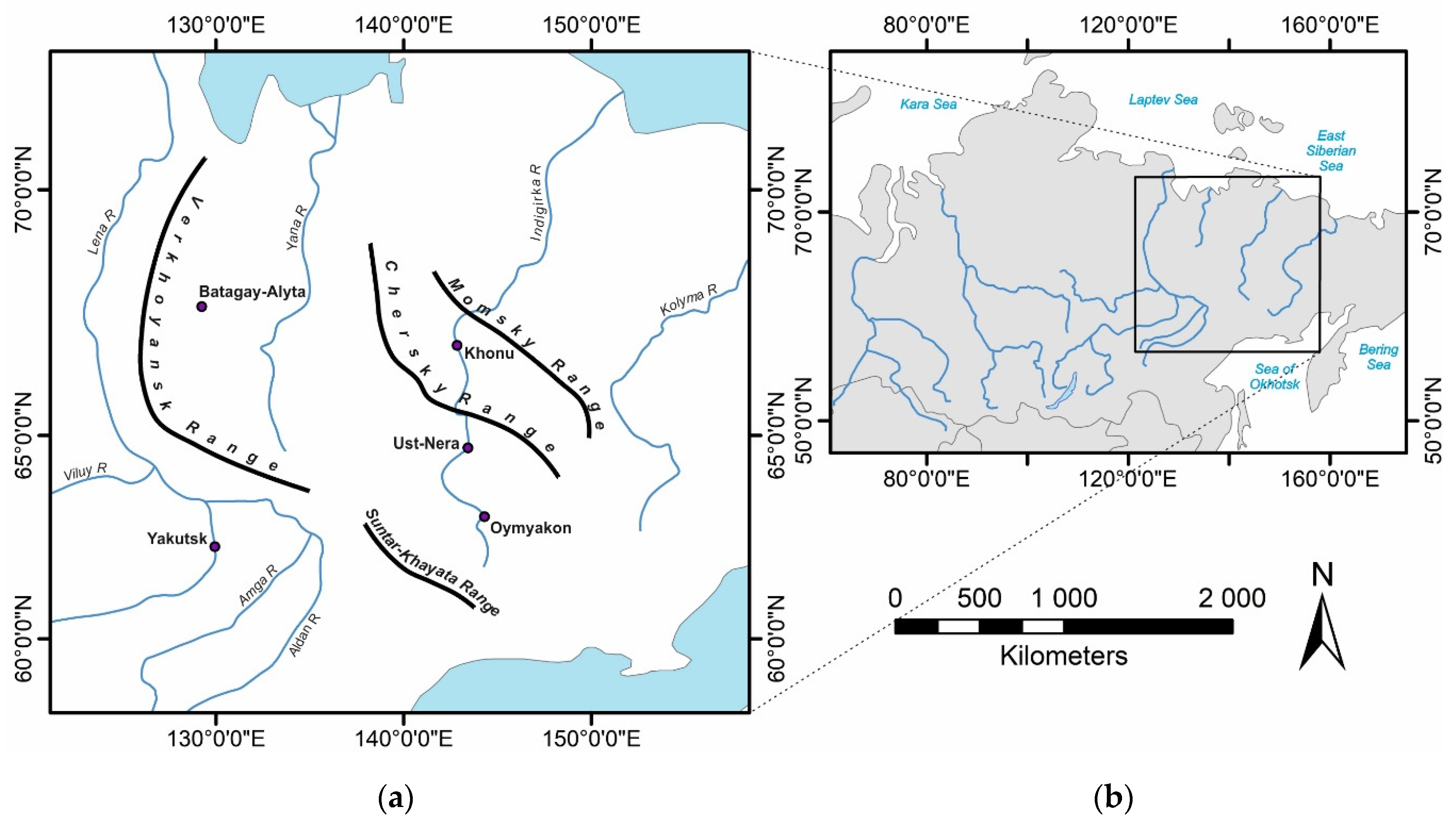
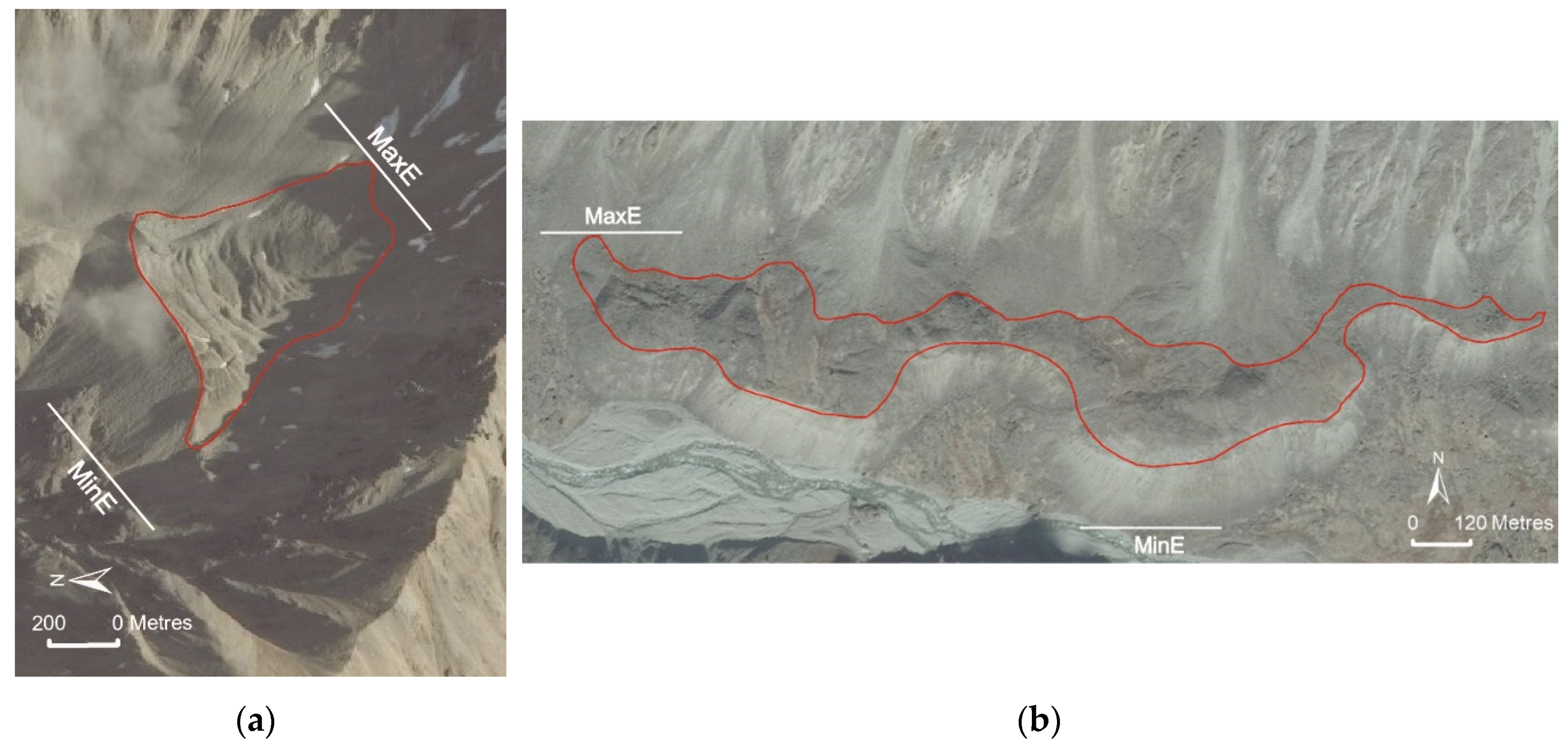
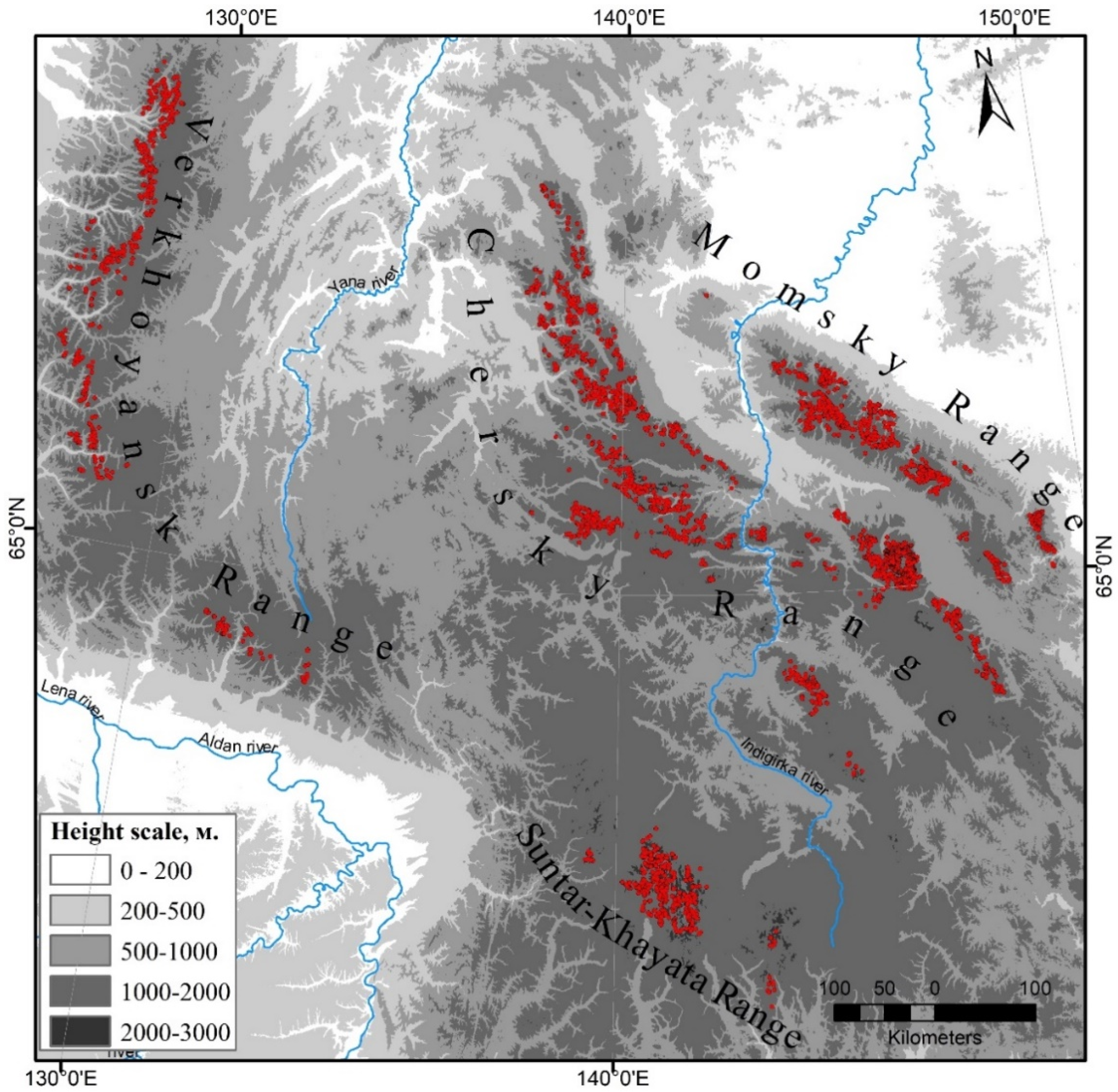
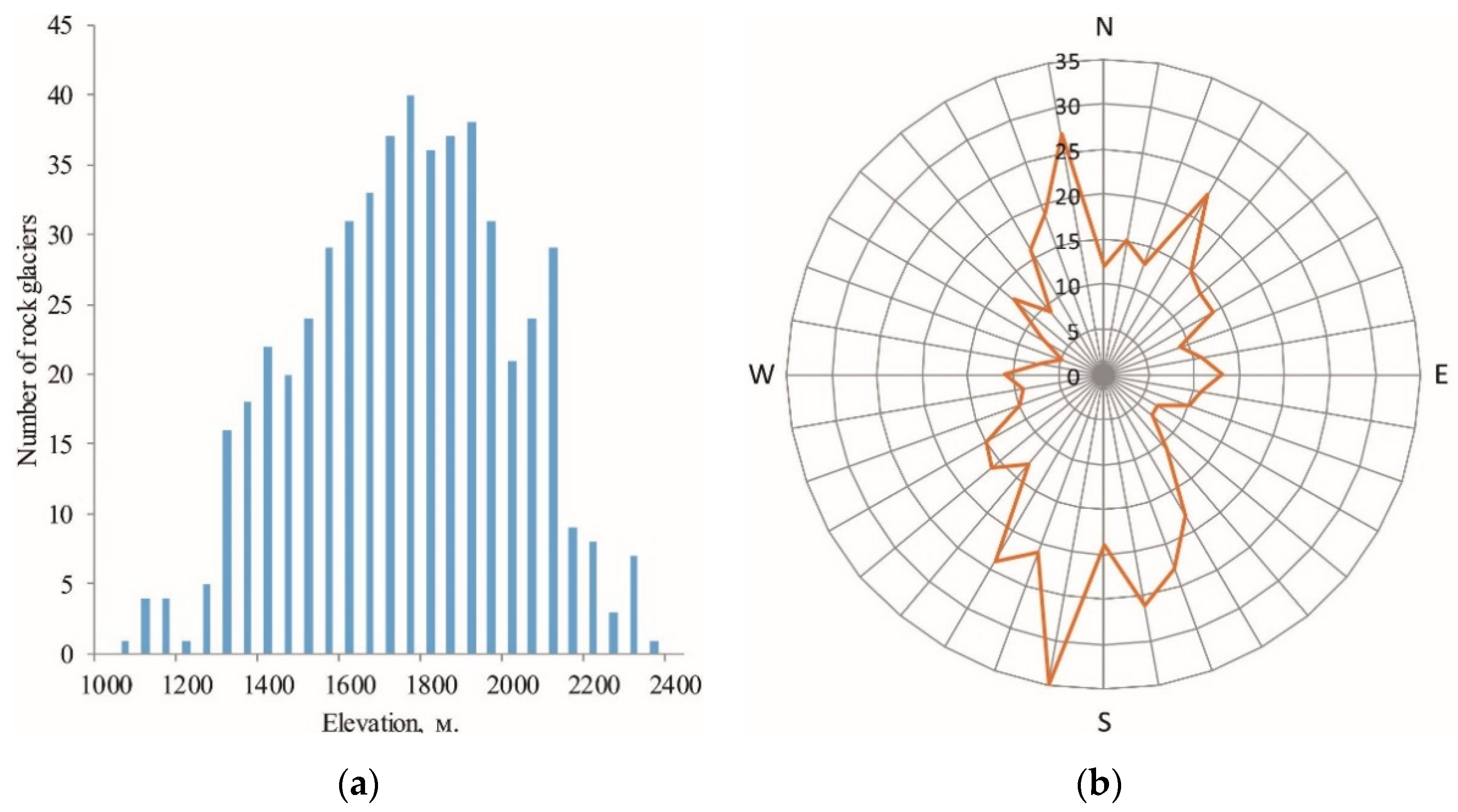

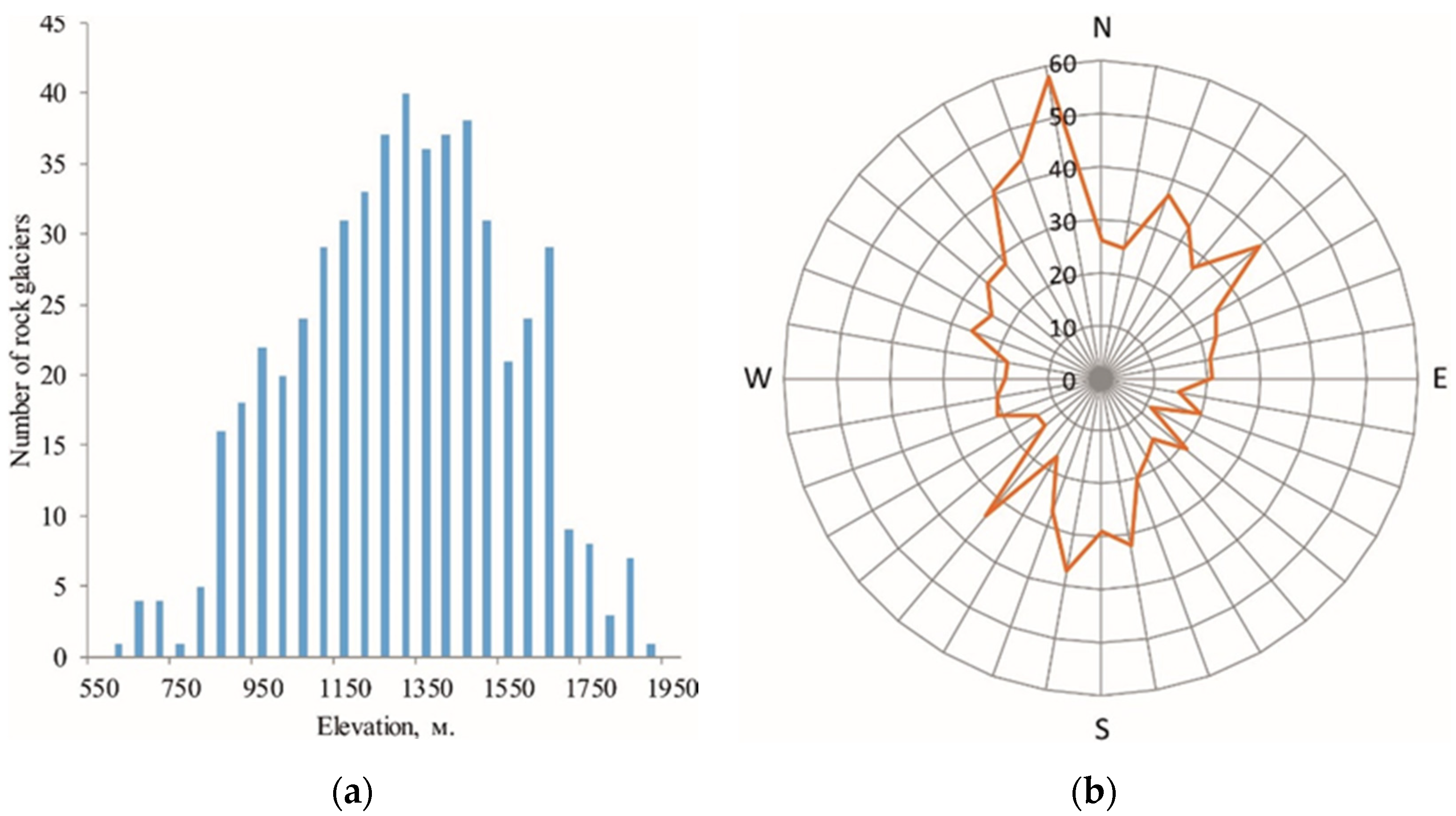
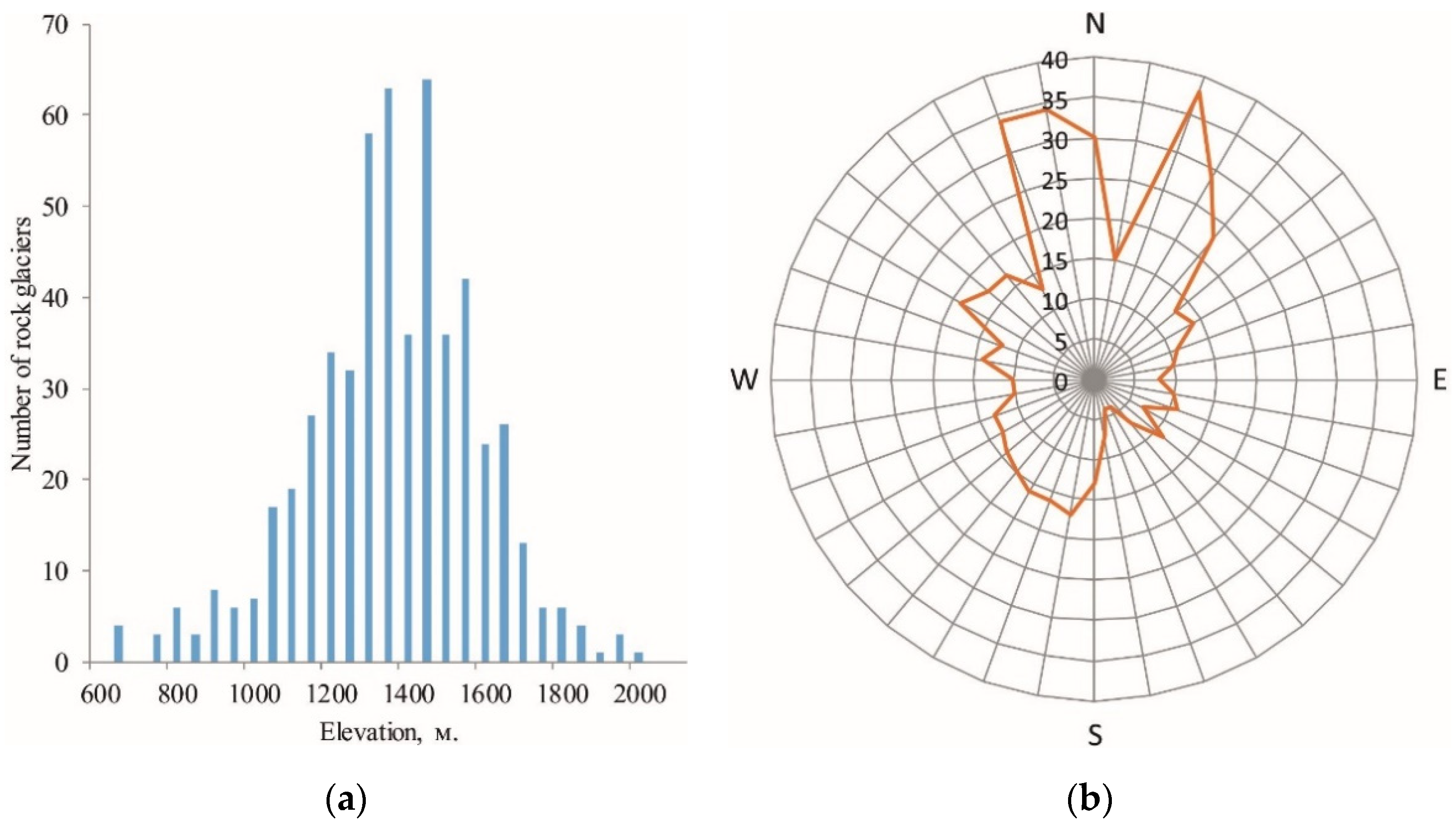
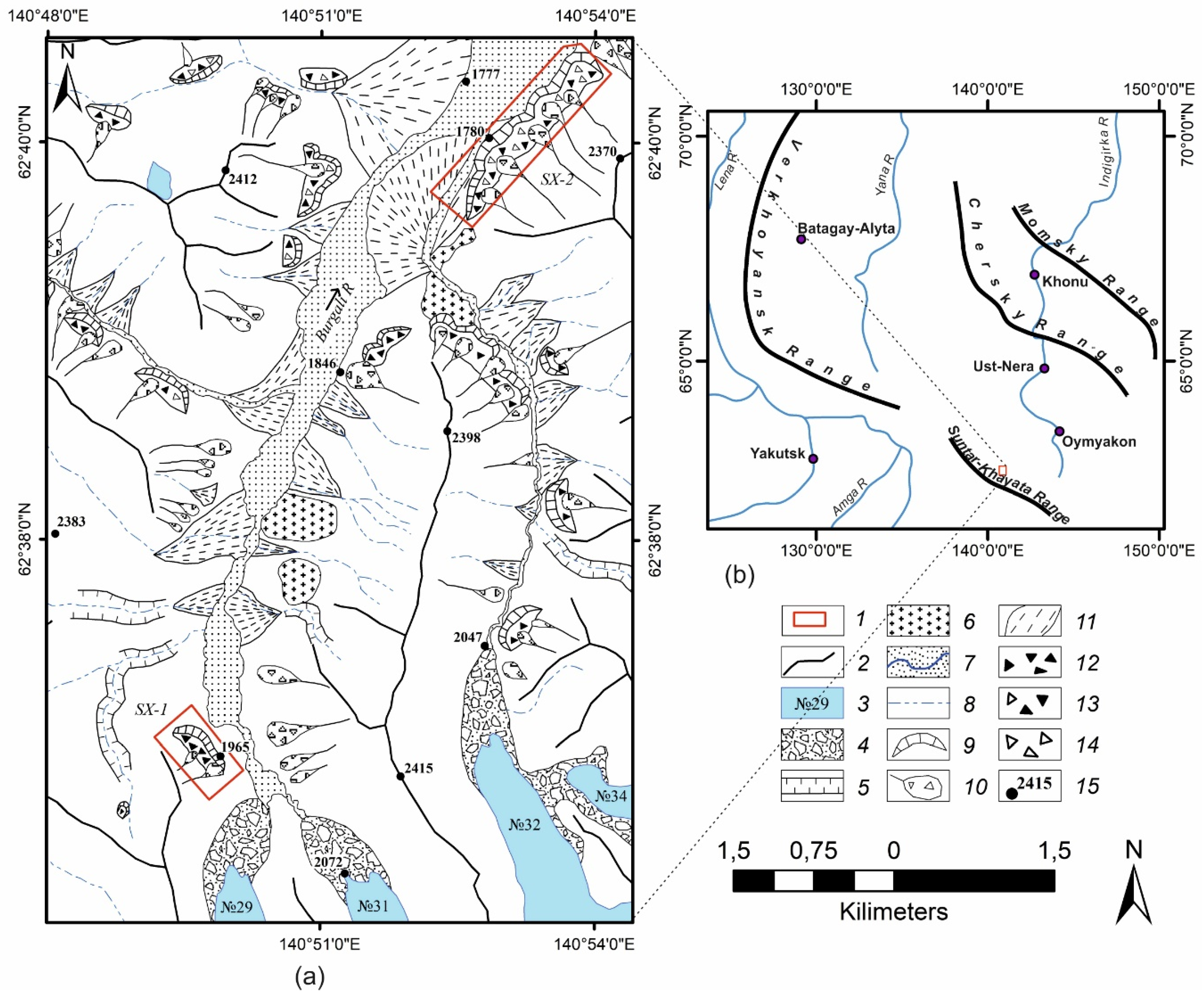
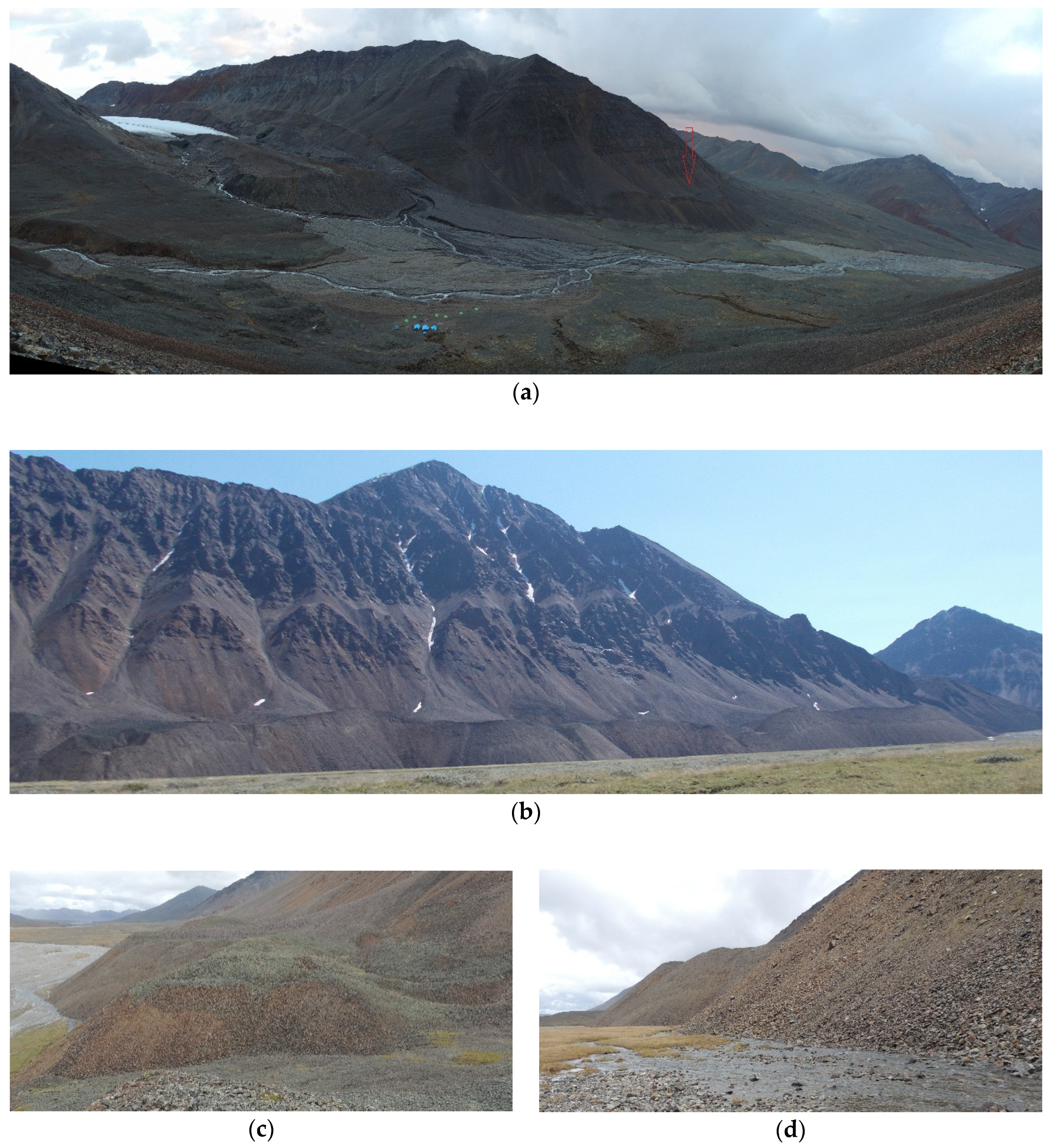
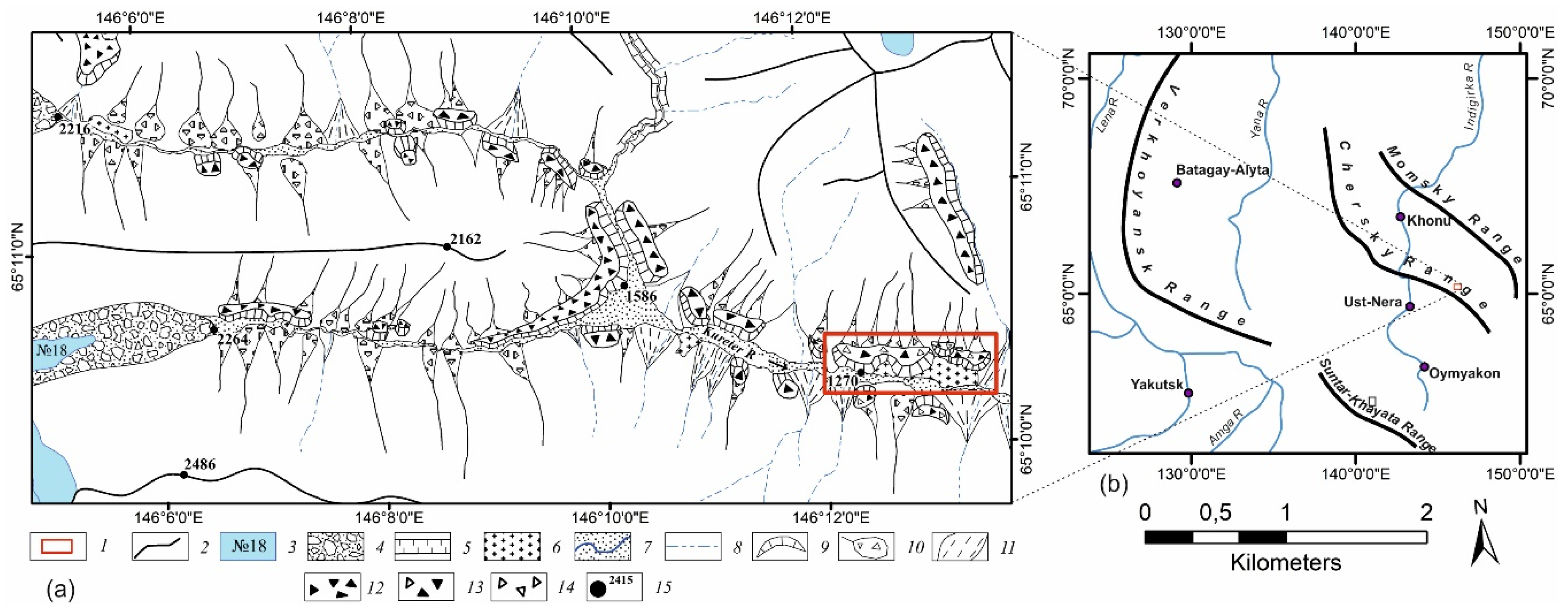
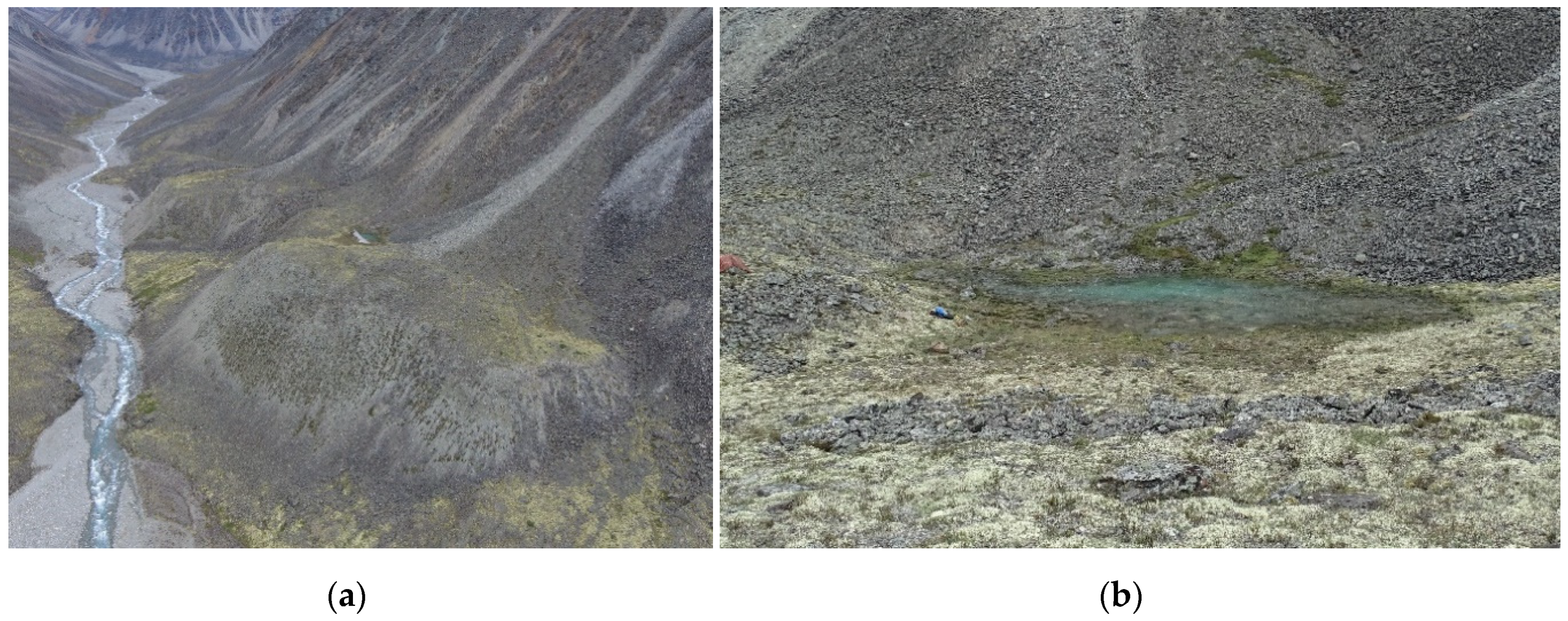
| Attribute | Meaning |
|---|---|
| RG ID | Rock glacier number |
| Area (km2) | Total area of the rock glacier |
| Min Ele (m asl) | Minimum elevation of the front of the rock glacier |
| Max Ele (m asl) | Maximum elevation of the rock glacier |
| Mean Ele | Mean elevation of the rock glacier |
| Aspect | Major aspect of the rock glacier in degrees |
| Location | Terrain location (cirque, sloping) |
| Complexity | Number of blades of rock glaciers (mono-or multi-lobed) |
| Dynamic Type | Severity of the relief (relict and intact) |
| Type of Rock Glacier | Quantity | Area (km2) | Area (%) | Mean Elevation, m Asl | MinE, m Asl | MaxE, m Asl |
|---|---|---|---|---|---|---|
| Slope: | 456 | 24.1 | 77.0 | 1775 | 1745 | 1808 |
| Intact | 405 | 18.8 | 60.0 | 1799 | 1770 | 1831 |
| Relict | 51 | 5.3 | 17.0 | 1584 | 1550 | 1624 |
| Cirque: | 73 | 7.2 | 23.0 | 2061 | 2002 | 2126 |
| Intact | 71 | 7.1 | 22.7 | 2067 | 2007 | 2133 |
| Relict | 2 | 0.1 | 0.3 | 1855 | 1818 | 1880 |
| Total | 529 | 31.3 | 1815 | 1780 | 1825 |
| Type of Rock Glacier | Quantity | Area (km2) | Area (%) | Mean Elevation, m Asl | MinF, m Asl | MaxE, m Asl |
|---|---|---|---|---|---|---|
| Slope: | 2190 | 83.6 | 78.7 | 1443 | 1417 | 1472 |
| Intact | 2049 | 74.2 | 69.9 | 1456 | 1430 | 1482 |
| Relict | 141 | 9.4 | 8.9 | 1254 | 1223 | 1288 |
| Cirque: | 309 | 22.6 | 21.3 | 1712 | 1660 | 1766 |
| Intact | 301 | 21.5 | 20.2 | 1712 | 1661 | 1766 |
| Relict | 8 | 1.1 | 1.0 | 1716 | 1656 | 1777 |
| Total | 2499 | 106.2 | 1476 | 1447 | 1508 |
| Type of Rock Glacier | Quantity | Area (km2) | Area (%) | Mean Elevation, m Asl | MEF, m Asl | MaxE, m Asl |
|---|---|---|---|---|---|---|
| Slope: | 646 | 29.0 | 57.4 | 1299 | 1271 | 1331 |
| Intact | 593 | 25.6 | 50.7 | 1326 | 1298 | 2358 |
| Relict | 43 | 3.4 | 6.7 | 999 | 968 | 1036 |
| Cirque: | 280 | 21.5 | 42.6 | 1646 | 1583 | 1708 |
| Intact | 253 | 19.5 | 38.6 | 1679 | 1615 | 1743 |
| Relict | 27 | 2.0 | 4.0 | 1336 | 1284 | 1385 |
| Total | 926 | 50.5 | 1404 | 1365 | 2214 |
| Type of Rock Glacier | Quantity | Area (km2) | Area (%) | Mean Elevation, m Asl | MEF, m Asl | MaxE, m Asl |
|---|---|---|---|---|---|---|
| Slope (Intact) | 198 | 15.5 | 42.3 | 1317 | 1282 | 1354 |
| Cirque (Intact) | 354 | 21.1 | 57.7 | 1471 | 1410 | 1536 |
| Total | 552 | 36.6 | 1386 | 1340 | 1436 |
| Research Area | Author | Area (km2) | Number | Dynamic Type | Mean Elev., m a.s.l. | Min n Elev., m | Max elev., m |
|---|---|---|---|---|---|---|---|
| Absaroka (North America) | Seligman Z. et al. [53] | - | 270 | all types | 2732 | 2093 | 3072 |
| Beartooth (North America) | Seligman Z. et al. | - | 391 | all types | 2929 | 2239 | 3443 |
| Colorado Front Range (North America) | Janke J. [54] | 19.9 | 220 | active | 3594 | 3525 | 3668 |
| inactive | 3477 | 3424 | 3541 | ||||
| fossil | 3288 | 3227 | 3358 | ||||
| Sierra Nevada (North America) | Millar C. et al. [10] | - | 289 | cirque | 3324 | 3242 | 3405 |
| valley wall | 3243 | 3201 | 3285 | ||||
| Central British Columbia Coast Mountains (North America) | Charbonneau A. et al. [46] | - | 165 | intact | 2195 | - | - |
| Uinta Mountains (North America) | Munroe J. [9] | - | 395 | all types | 3285 | 3243 | 3341 |
| Central Patagonia (South America) | Selley H. et al. [55] | 14.18 | 89 | intact | 1766 | 1941 | |
| relict | 1758 | 1919 | |||||
| Aconcagua River Basin (South America) | Janke J. et al. [56] | 70.0 | 669 | all types | 3810 | 2370 | 4565 |
| Central Andes (Atacama region) (South America) | Garcia A. et al. [57] | 44.34 | 477 | all types | 4427 | 3807 | 5504 |
| San Juan Dry Andes (South America) | Esper Angillieri M. Y. [8] | - | 526 | all types | 4106 | - | - |
| Chilean Andes (South America) | Azocar G. et al. [7] | - | 3575 | - | - | - | |
| Volcán Domuyo region (~36° S), southernmost Central Andes (South America) | Falaschi D. et al. [58] | 17.7 | 224 | active | 3047 | 3968 | 2664 |
| inactive | 2821 | 3526 | 2165 | ||||
| relict | 2644 | 3340 | 1955 | ||||
| Monte San Lorenzo massif (South America) | Falaschi D. et al. [59] | 11.31 | 177 | intact | 1742 | 2155 | 1335 |
| fossil | 1590 | 2030 | 1267 | ||||
| Valles Calchaquíes Region (South America) | Falaschi D. et al. [60] | 58.5 | 488 | intact | 4873 | 5908 | 4183 |
| fossil | 4695 | 5397 | 4072 | ||||
| Western Tatra Mts. (Europe) | Uxa T. [4] | 7.14 | 183 | intact | - | 1812 | - |
| relict | - | 1644 | - | ||||
| High Tatra Mts. (Europe) | Uxa T. [4] | 6.7 | 200 | intact | - | 2011 | - |
| relict | - | 1731 | - | ||||
| Southern Carpathian (Europe) | Onaca A. et al. [61] | 12.7 | 306 | all types | 1998 | - | - |
| Southern regionof the eastern Italian Alps (Europe) | Seppi R. et al. [62] | 33.3 | 705 | intact | 2632 | 3082 | 2716 |
| relict | 2669 | 2169 | 1644 | ||||
| South-eastern Alps (Europe) | Colucci R. et al. [2] | 3.45 | 53 | all types | 1778 | - | - |
| Adamello-Presanella Massif (Italian Alps) (Europe) | Baroni C. et al. [63] | - | 216 | all types | - | 2349 | 2232 |
| Tyrolean Alps (Europe) | Krainer K. et al. [64] | 167.2 | 3145 | active | 2704 | 2797 | 2628 |
| inactive | 2598 | 2665 | 2542 | ||||
| fossil | 2330 | 2384 | 2279 | ||||
| Nepalese Himalaya (Asia) | Jones D. et al. [12] | 249.83 | 6239 | intact | 5215 | 4977 | |
| relict | 4738 | 4541 | |||||
| Himachal Himalaya (Asia) | Pandey P. [38] | 353 | 516 | all types | - | 4900 | 4484 |
| TienShan of China (Asia) | Wang X. et al. [65] | 91.5 | 261 | all types | - | 3486 | 3174 |
| Daxue Shan, south-eastern Tibetan Plateau (Asia) | Ran Z. et al. [13] | 55.70 | 295 | all types | 4471 | - | 4352 |
| Karakoram, Tien Shan, Altai (Asia) | Blothe J. et al. [14] | 452 | 2082 | - | - | - | - |
© 2020 by the author. Licensee MDPI, Basel, Switzerland. This article is an open access article distributed under the terms and conditions of the Creative Commons Attribution (CC BY) license (http://creativecommons.org/licenses/by/4.0/).
Share and Cite
Lytkin, V. Inventory and Distribution of Rock Glaciers in Northeastern Yakutia. Land 2020, 9, 384. https://doi.org/10.3390/land9100384
Lytkin V. Inventory and Distribution of Rock Glaciers in Northeastern Yakutia. Land. 2020; 9(10):384. https://doi.org/10.3390/land9100384
Chicago/Turabian StyleLytkin, Vasylii. 2020. "Inventory and Distribution of Rock Glaciers in Northeastern Yakutia" Land 9, no. 10: 384. https://doi.org/10.3390/land9100384
APA StyleLytkin, V. (2020). Inventory and Distribution of Rock Glaciers in Northeastern Yakutia. Land, 9(10), 384. https://doi.org/10.3390/land9100384





